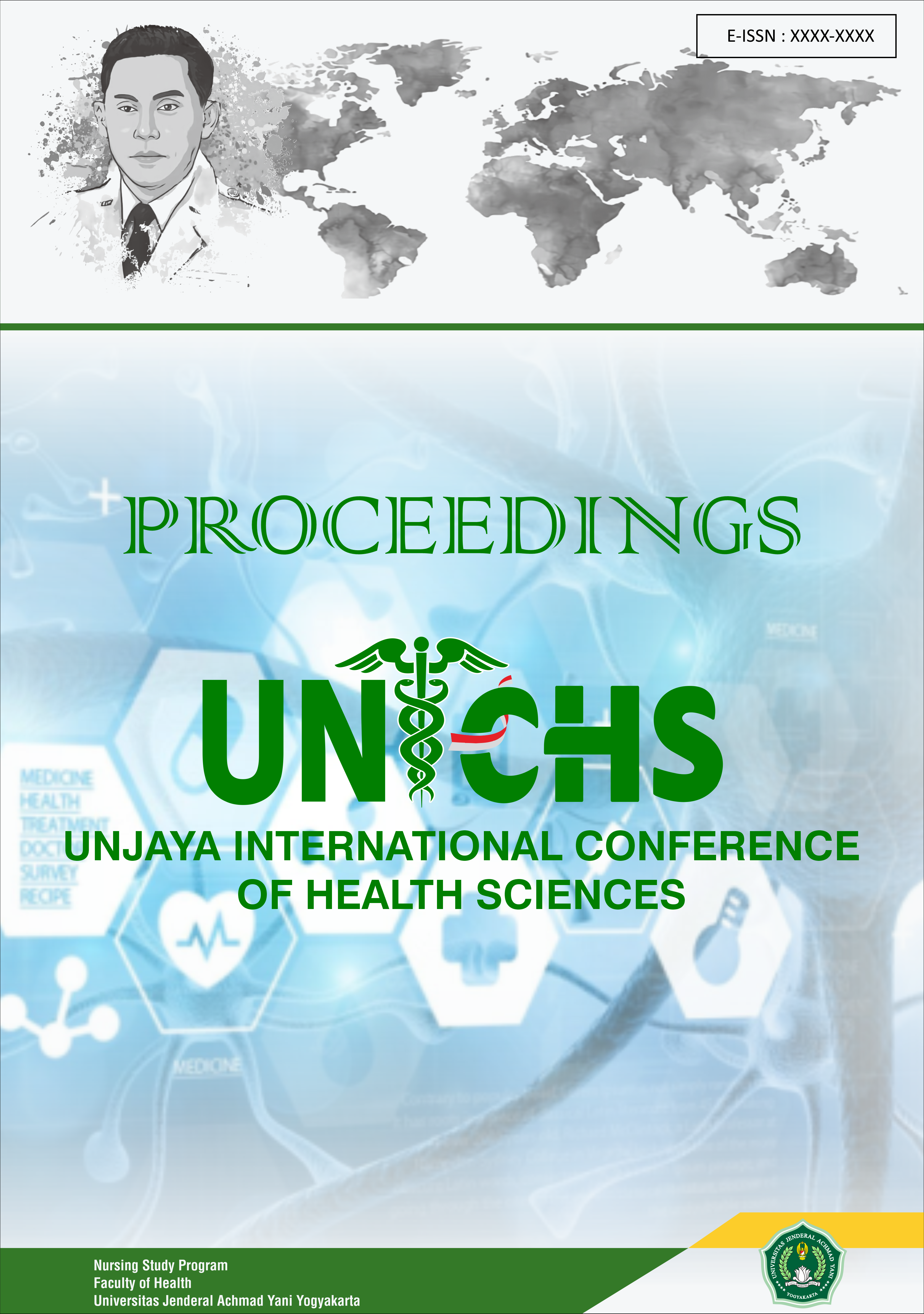Potential Interaction of Costunolide and Dehydrocostuslactone Compounds on Proteins Associated With Non-Alcoholic Fatty Liver Disease in An In-Silico Study
Keywords:
Costunolide, Dehydrocostuslactone, NAFLD, NF-ĸB, S. CostusAbstract
Background: Non-alcoholic Fatty Liver Disease (NAFLD) is a growing health problem but there is no standard drug for its treatment. Costunolide and dehydrocostuslactone is the compound of Saussurea costus, and an antioxidant that has activities as anti-hepatotoxic, anti-inflammatory, and immunostimulants, which have been proven in-vivo and in-vitro.
Purpose: This study aims to identify the bioactive ingredients of S. costus that affect NAFLD and explore its therapeutic targets through pharmacological networking.
Methods: Various tissue databases were identified to get the bioactive material S. costus and identify NAFLD therapeutic targets. Gene ontology enrichment (GO) and the Kyoto Encyclopedia of Genes and Genomes (KEGG) were performed to enrich the functions and molecular pathways of common targets. The analysis was carried out through the Structure-Activity-Relationship (SAR) search, with the determination of a range score of 0-1, where the closer to 1 the better the value.
Results: The results of the Structure-Activity-Relationship (SAR) analysis were that the costunolide and dehydrocostuslactone compounds had scored <0.5 as a hepatoprotector and as a regulator of fat metabolism. The potential of these two compounds as TNF-alpha inhibitors and Interleukin-6 antagonists also shows a score <0.5. Costunolide and Dehydrocostuslactone showed a score >0.5 for their activity as anti-inflammatory and NF-ĸB transcription inhibitors, indicating the existence of anti-inflammatory potential, and the potential as a candidate for NAFLD therapy indicated by the NF-ĸB transcription inhibitory pathway.
Conclusion: Costunolide, and Dehydrocostuslactone showed anti-inflammatory potential, and the presumed potential as a candidate for NAFLD therapy was shown to inhibit the transcription pathway of NF-ĸB
References
Abdulqahar FW, Hussein FF. In-Silico Anti-SARS-CoV-2 Activity of Different Bioactives Green-Extracted from the Medicinal Plant Saussurea lappa Clarck. In: IOP Conference Series: Earth and Environmental Science. Institute of Physics; 2023.
Barghchi H, Milkarizi N, Belyani S, Norouzian Ostad A, Askari VR, Rajabzadeh F, et al. Pomegranate (Punica granatum L.) peel extract ameliorates metabolic syndrome risk factors in patients with non-alcoholic fatty liver disease: a randomized double-blind clinical trial. Nutr J. 2023 Dec 1;22(1).
Beiriger J, Chauhan K, Khan A, Shahzad T, Parra NS, Zhang P, et al. Advancements in Understanding and Treating NAFLD: A Comprehensive Review of Metabolic-Associated Fatty Liver Disease and Emerging Therapies. Vol. 3, Livers. Multidisciplinary Digital Publishing Institute (MDPI); 2023. p. 637–56.
Berardo C, Di Pasqua LG, Cagna M, Richelmi P, Vairetti M, Ferrigno A. Nonalcoholic fatty liver disease and non-alcoholic steatohepatitis: Current issues and future perspectives in preclinical and clinical research. Vol. 21, International Journal of Molecular Sciences. MDPI AG; 2020. p. 1–30.
Byrne CD, Targher G. What’s new in NAFLD pathogenesis, biomarkers and treatment? Nat Rev Gastroenterol Hepatol. 2020 Feb 1;17(2):70–1.
Chalasani N, Younossi Z, Lavine JE, Charlton M, Cusi K, Rinella M, et al. The Diagnosis and Management of Nonalcoholic Fatty Liver Disease: Practice Guidance From the American Association for the Study of Liver Diseases. 2017; Available from: http://journals.lww.com/hep
Chen Y, Zheng H, Zhang J, Wang L, Jin Z, Gao W. Reparative activity of costunolide and dehydrocostus in a mouse model of 5-fluorouracil-induced intestinal mucositis. RSC Adv. 2016;6(7):5249–58.
Devillers J, Devillers H. Structure–Activity Relationship (SAR) Modeling of Mosquito Repellents: Deciphering the Importance of the 1-Octanol/Water Partition Coefficient on the Prediction Results. Applied Sciences (Switzerland). 2024 Jul 1;14(13).
Flieger J, Flieger W, Baj J, Maciejewski R. Antioxidants: Classification, natural sources, activity/capacity measurements, and usefulness for the synthesis of nanoparticles. Vol. 14, Materials. MDPI AG; 2021.
Godoy-Matos AF, Silva Júnior WS, Valerio CM. NAFLD as a continuum: From obesity to metabolic syndrome and diabetes. Vol. 12, Diabetology and Metabolic Syndrome. BioMed Central; 2020.
Han SK, Baik SK, Kim MY. Non-alcoholic fatty liver disease: Definition and subtypes. Vol. 29, Clinical and Molecular Hepatology. Korean Association for the Study of the Liver; 2023. p. S5–16.
Jubayer, Fahad M, Shahidullah Kayshar M, Anisur Rahman Mazumder M, Sabrina Akter S, Fahad Jubayer Assistant Professor M. A review on five medicinal plants considering the therapeutic potentials in the management of COVID-19 [Internet]. 2020 [cited 2024 Jun 19]. Available from: https://www.researchgate.net/publication/347760082_A_review_on_five_medicinal_plants_considering_the_therapeutic_potentials_in_the_management_of_COVID-19
Karamalakova YD, Nikolova GD, Georgiev TK, Gadjeva VG, Tolekova AN. Hepatoprotective properties of Curcuma longa L. extract in bleomycin-induced chronic hepatotoxicity. Drug Discov Ther. 2019 Feb 28;13(1):9–16.
Kim DY, Choi BY. Costunolide—A Bioactive Sesquiterpene Lactone with Diverse Therapeutic Potential. Int J Mol Sci. 2019 Jun 14;20(12):2926.
Lestari DL, Jurnalis YD, Lubis G, Ali H, Sayoeti Y. Hubungan Kadar Docosahexaenoic Acid Terhadap Perlemakan Hati Non Alkoholik Remaja Obesitas. Vol. 23. 2021.
Liu X nan, Li H min, Wang S ping, Zhang J ze, Liu D lin. Sesquiterpene lactones of Aucklandia lappa: Pharmacology, pharmacokinetics, toxicity, and structure–activity relationship. Vol. 13, Chinese Herbal Medicines. Elsevier B.V.; 2021. p. 167–76.
Nadda RK, Ali A, Goyal RC, Khosla PK, Goyal R. Aucklandia costus (Syn. Saussurea costus): Ethnopharmacology of an endangered medicinal plant of the himalayan region. Vol. 263, Journal of Ethnopharmacology. Elsevier Ireland Ltd; 2020.
National Center for Biotechnology Information. PubChem Substance Record for SID 135029944, Costunolide. 2024a.
National Center for Biotechnology Information. PubChem Compound Summary for CID 73174, Dehydrocostus lactone. 2024b.
Parlati L, Régnier M, Guillou H, Postic C. New targets for NAFLD. Vol. 3, JHEP Reports. Elsevier B.V.; 2021.
Rahman MA, Hasan NAHM, Mondal M, Uddin M, Wahed TB, Alam KKM. Evaluation of Antioxidant, Cytotoxic and Hepato-protective Effect of Bridelia tomentosa Fruit Extract. Tropical Journal of Natural Product Research. 2023;7(12):5453–9.
Rao Vadaparthi PR, Kumar K, Sarma VUM, Hussain QA, Babu KS. Estimation of Costunolide and Dehydrocostus Lactone in Saussurea lappa and its Polyherbal Formulations followed by their Stability Studies Using HPLC-DAD. Pharmacogn Mag. 2015 Jan 1;11(41):180–90.
Santos-Sánchez NF, Salas-Coronado R, Villanueva-Cañongo C, Hernández-Carlos B. Antioxidant Compounds and Their Antioxidant Mechanism [Internet]. Available from: www.intechopen.com
Semwal RB, Joshi K, Pandian A, Badoni PP, Semwal DK. Article ID 201 J Convent Knowl Holist Health. Vol. 2020, J Convent Knowl Holist Health. 2020.
Setiono DD, Wantania FEN, Polii EBI. Risk Factors of Non-Alcoholic Fatty Liver Disease in Adults. e-CliniC. 2022 May 14;10(2):234.
Shati AA, Alkahtani MA, Alfaifi MY, Elbehairi SEI, Elsaid FG, Prasanna R, et al. Secondary Metabolites of Saussurea costus Leaf Extract Induce Apoptosis in Breast, Liver, and Colon Cancer Cells by Caspase-3-Dependent Intrinsic Pathway. Biomed Res Int. 2020;2020.
Toda Y, Shigemori H, Ueda J, Miyamoto K. Isolation and identification of polar auxin transport inhibitors from Saussurea costus and Atractylodes japonica. Acta Agrobot. 2017;70(3).
Tejaswi JKD, Rajan DrRG, Sara P. Study of Hepatoprotective Activity of Saussurea Lappa Root Extract. International Journal of Trend in Scientific Research and Development [Internet]. 2018 Oct 31;Volume-2(Issue-6):55–60. Available from: https://www.ijtsrd.com/pharmacy/analytical-chemistry/18390/study-of-hepatoprotective-activity-of-saussurea-lappa-root-extract/juluri-krishna-dutta-tejaswi
Xu Z, Lin S, Gong J, Feng P, Cao Y, Li Q, et al. Exploring the Protective Effects and Mechanism of Crocetin From Saffron Against NAFLD by Network Pharmacology and Experimental Validation. Front Med (Lausanne). 2021 Jun 9;8.
Yan Z, Xu T, An Z, Hu Y, Chen W, Ma J, et al. Costunolide induces mitochondria-mediated apoptosis in human gastric adenocarcinoma BGC-823 cells. BMC Complement Altern Med. 2019 Jun 26;19(1).






